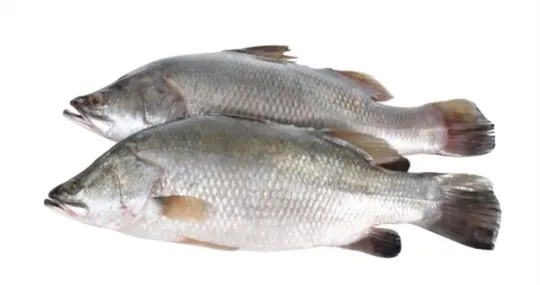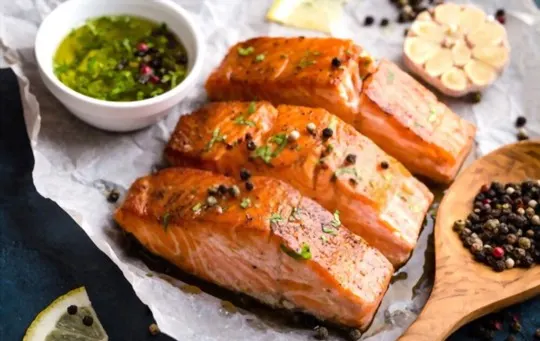Diving into the sea of fish options, we land on two big fishes: barramundi and salmon. Both pack a punch nutrition-wise.
Why do we care? Well, we all want that heart-healthy omega-3, right? Barramundi swims in with a sustainability badge, while salmon flaunts those omega-3 fatty acids we’re all after.
Our kitchens have seen both. Grilling, baking, or pan-frying, we’ve done it. We’re here to give you the lowdown, no fluff.
Which fish will scale to the top for us? The battle lines are drawn.

What is Barramundi?

Barramundi is a type of fish that is native to the Indo-Pacific region.
It is known for its delicate, flaky texture and mild flavor, making it a popular seafood option.
Barramundi is also recognized for being a sustainable and environmentally friendly choice due to its efficient growth rate, low-impact farming techniques, and minimal environmental impact.
It is high in protein, omega-3 fatty acids, and essential vitamins and minerals, making it a healthy addition to any diet.
It’s also worth mentioning that barramundi can be cooked using various methods including grilling, baking, frying or steaming which makes it versatile in recipes as well as an ideal option for health-conscious individuals looking for alternative protein sources without compromising on taste or nutrition.
What is Salmon?

Salmon is a popular fish among seafood lovers, known for its distinct taste and nutritional value.
This type of fish has a rich, pink color and can be found in both freshwater and saltwater environments.
With high levels of omega-3 fatty acids, salmon can provide excellent health benefits to individuals who consume it on a regular basis.
It is also a versatile fish that can be cooked in numerous ways making it a favorite ingredient for many dishes.
Differences Between Barramundi and Salmon

When it comes to seafood, Barramundi and Salmon are two popular options for many.
But what sets them apart?
In terms of taste, Barramundi has a mild, buttery flavor while Salmon is richer and stronger in taste.
In terms of texture, Barramundi is flakier and firmer whereas Salmon is oilier and softer.
When it comes to nutritional value, both fish are rich in protein and omega-3 fatty acids but Salmon has a higher fat content.
Barramundi, on the other hand, is lower in calories and saturated fats.
Interestingly, Barramundi is a more sustainable option as it can be farmed in ways that have less impact on the environment compared to salmon farming which can lead to pollution of natural waterways.
Overall, both fish have their own unique qualities and it ultimately comes down to personal preferences and concerns about sustainability when deciding which one to choose.
1 – Flavor and Taste
Flavor and Taste play a pivotal role in deciding which fish to choose for your meal.
With Barramundi and Salmon being popular choices, it’s important to know which one fares better in terms of taste buds.
Here’s an objective evaluation of the two contenders based on flavor and taste:
- Barramundi has a rich but mild flavor profile that is often compared to Grouper or Sea Bass. It has a buttery texture that melts in your mouth, making it an excellent choice for grilling or baking dishes.
- On the other hand, Salmon has a strong and distinct flavor described as “fishy” by some and appreciated by others. Its bright orange flesh offers more significant servings of omega-3 fatty acids and is usually enjoyed pan-seared or grilled.
- In comparison to salmon, barramundi has less fishiness in its taste with a delicate flavor that maintains its deliciousness even after cooking, unlike salmon.
Both barramundi and salmon can be prepared using different recipes according to individual preferences.
However, if you’re more inclined towards mild-flavored seafood, barramundi could be an excellent choice for you.
2 – Texture and Appearance
The texture and appearance of barramundi and salmon are notable aspects that distinguish them from each other.
Barramundi has a firm and meaty texture with a mild flavor, while salmon is known for its flaky and delicate texture with a distinct flavor.
The pinkish-red color of salmon is due to its high levels of astaxanthin, while barramundi has a white flesh color.
These attributes affect the culinary use of both fish varieties in unique ways.
3 – Nutritional Profile
The nutrient composition of Barramundi and Salmon differs significantly.
Barramundi is an excellent source of Omega-3 fatty acids and high-quality protein.
Its fillets contain substantial amounts of iodine, potassium, and vitamin B12.
In contrast, Salmon has higher levels of Omega-3 fatty acids and vitamin D than any other fish.
It also provides a good amount of calcium and vitamin B12 while containing a healthy dose of niacin, selenium, and phosphorous.
Both fish offer unique nutritional benefits that can support a balanced diet, making either option a great addition to a healthy meal plan.
4 – Environmental Impact
The environmental impact of each fish varies significantly.
It is imperative to consider the sustainability and ecological footprint of farming these species.
Salmon farming demands high quantities of wild-caught fish for feed, contributing to reduced seafood stock and ecological imbalance.
Barramundi farming can be done on an ecologically stable basis, allowing for sustainable production with minimal ecological harm.
Similarities Between Barramundi and Salmon

Barramundi and salmon share a number of similarities.
- Both are popular seafood choices with tender flesh, have high nutritional value, and provide excellent lean protein sources.
- They are also both available in fillets or whole fish options at grocery stores and farmers markets.
Their similarities, however, do not end there.
Barramundi and salmon share comparable cooking methods, including grilling or baking for a short time period, making them perfect for weeknight dinners.
In addition, they both can be used in sushi dishes as their flesh is capable of absorbing flavors without becoming too overpowering.
Both types of fish also offer various health benefits.
Salmon is applauded for its heart-healthy omega-3 fatty acids while barramundi stands out because it is rich in Vitamin D, which helps the body absorb calcium and strengthen bones.
Cooking and Culinary Uses
Barramundi and salmon are versatile seafood options with different flavors, textures, and cooking methods.
These fish can be cooked using various techniques such as grilling, smoking, baking, or frying.
When it comes to culinary usage, barramundi is widely used in Asian cuisines due to its sweet flavor and moist texture that pairs well with spicy sauces and herbs.
On the other hand, salmon is popular globally for its rich flavor and fatty texture that complements cream-based dishes like pasta or soups.
Both fish offer a plethora of culinary options suitable for any occasion or dish.
In terms of specific culinary usages, barramundi can be grilled with citrus fruits or paired with mango salsa to bring out its sweet flavor.
It can also be poached in a coconut curry sauce or steamed with Thai herbs for an authentic taste.
Whereas salmon can be baked in butter herb sauce or pan-seared with lemon butter glaze for an extra burst of flavor.
It can also be smoked along with cedar wood to give it a smoky taste.
Overall, both barramundi and salmon have unique flavors and nutritional benefits that make them a great choice for any seafood lover.
Their culinary uses are abundant and vary depending on the appropriate cooking method and recipe chosen.
Sustainability Considerations
To maintain our ecosystem’s balance, it’s necessary to make informed choices about the fish we consume.
Considering ecological factors while deciding between Barramundi and Salmon is essential.
An alternative to “Sustainability Considerations” is Ecological Impacts, which considers farmed fish’s impact on the environment.
Focusing on the types of food that are a part of the fish’s feed and how they are raised can help make an informed decision.
Conclusion
Comparing barramundi to salmon, both are healthy options for a balanced diet.
However, barramundi is a more sustainable and cost-effective option.
It has a mild flavor, making it versatile for various recipes and cooking methods.
Salmon, on the other hand, has a distinct taste and is packed with omega-3 fatty acids.
When choosing between the two, consider sustainability, budget, and personal preferences.
Ultimately, each fish offers unique benefits and can be incorporated into a well-rounded diet.
